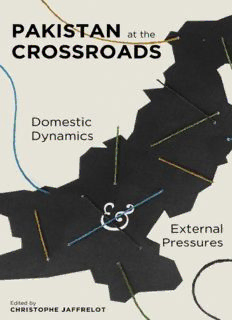
Pakistan at the Crossroads: Domestic Dynamics and External Pressures PDF
Preview Pakistan at the Crossroads: Domestic Dynamics and External Pressures
PAKISTAN AT THE CROSSROADS RELIGION, CULTURE, AND PUBLIC LIFE RELIGION, CULTURE, AND PUBLIC LIFE Series Editor: Karen Barkey The resurgence of religion calls for careful analysis and constructive criticism of new forms of intolerance, as well as new approaches to tolerance, respect, mutual understanding, and accommodation. In order to promote serious scholarship and informed debate, the Institute for Religion, Culture, and Public Life and Columbia University Press are sponsoring a book series devoted to the investigation of the role of religion in society and culture today. This series includes works by scholars in religious studies, political science, history, cultural anthropology, economics, social psychology, and other allied fields whose work sustains multidisciplinary and comparative as well as transnational analyses of historical and contemporary issues. The series focuses on issues related to questions of difference, identity, and practice within local, national, and international contexts. Special attention is paid to the ways in which religious traditions encourage conflict, violence, and intolerance and also support human rights, ecumenical values, and mutual understanding. By mediating alternative methodologies and different religious, social, and cultural traditions, books published in this series will open channels of communication that facilitate critical analysis. For a complete list of the books in this series, see Series List. PAKISTAN AT THE CROSSROADS DOMESTIC DYNAMICS AND EXTERNAL PRESSURES CHRISTOPHE JAFFRELOT EDITOR COLUMBIA UNIVERSITY PRESS ■ NEW YORK Columbia University Press Publishers Since 1893 New York Chichester, West Sussex cup.columbia.edu Copyright © 2016 Columbia University Press All rights reserved E-ISBN 978-0-231-54025-4 Library of Congress Cataloging-in-Publication Data Pakistan at the crossroads : domestic dynamics and external pressures / Christophe Jaffrelot, (ed.). pages ; cm.—(Religion, culture, and public life) Includes bibliographical references and index. ISBN 978-0-231-17306-3 (cloth : alk. paper) ISBN 978-0-231-54025-4 (e-book) 1. Pakistan— Politics and government. 2. Pakistan—Foreign relations. I. Jaffrelot, Christophe, editor. II. Series: Religion, culture, and public life. DS389.P34264 2016 954.9105'3—dc23 2015024699 A Columbia University Press E-book. CUP would be pleased to hear about your reading experience with this e-book at cup- [email protected]. Cover design: Martin Hinze References to websites (URLs) were accurate at the time of writing. Neither the author nor Columbia University Press is responsible for URLs that may have expired or changed since the manuscript was prepared. CONTENTS Acknowledgments Introduction: Pakistan, the Interface State Christophe Jaffrelot PART I: THE DOMESTIC SCENE 1 The Military and Democracy Aqil Shah 2 The Operational Dynamics of Political Parties in Pakistan Mohammad Waseem 3 The Judiciary as a Political Actor Philip Oldenburg 4 Turmoil in the Frontier Mariam Abou Zahab 5 Internal Security Issues in Pakistan: Prospects of Police and Law Enforcement Reform Hassan Abbas 6 Pakistan’s Economy: Domestic Dissent and Foreign Reliance Shahid Javed Burki and Adnan Naseemullah PART II: THE INTERNATIONAL DIMENSIONS 7 Pakistan–Afghanistan Relations Since 2001: There Are No Endgames Avinash Paliwal 8 U.S.–Pakistan Relations Under Obama: Resilience of Clientelism? Christophe Jaffrelot 9 Pakistan–China Symbiotic Relations Farah Jan and Serge Granger 10 Pakistan Between Saudi Arabia and Iran: Islam in the Politics and Economics of Western Asia Sana Haroon List of Contributors Index ACKNOWLEDGMENTS This collection of essays draws from two conferences that were organized at Columbia University thanks to the support of the Alliance Program (Columbia University, Sciences Po, Polytechnique, and Paris 1—Sorbonne). These meetings were hosted by the Center for Democracy, Toleration, and Religion, now a part of the Institute for Religion, Culture, and Public Life (IRCPL). These meetings would not have been possible without the personal involvement of Alfred Stepan, who engaged with the participants in the most stimulating way on both occasions. Melissa Van, assistant director of IRCPL, played a key role in the organization of these conferences and in the finalization of the book. Karen Barkey, the successor of Al Stepan at the helm of the IRCPL, and Walid Hammam, her assistant director, subsequently made the publication of this book possible. Last but not least, the formatting of this volume owes much to Maryam Mastoor, whose dedication to the cause of scholarship impressed me when she worked at the Centre de Recherches Internationales (CERI), at Sciences Po, my alma mater in Paris, as an intern. INTRODUCTION PAKISTAN, THE INTERFACE STATE Christophe Jaffrelot Pakistan has been characterized by scholars as, among other things, an “ideological state” (like Israel), because of the political reinterpretation of Islam by its founding fathers, including Muhammad Ali Jinnah; a “garrison state,” because of the key role of the military; and as a “terror state,” because of the rise of radical Islamic movements in its midst. But its trajectory may be best captured by another, encompassing, feature not contradictory with the qualifications mentioned above: its ability to navigate at the interface of domestic and external dynamics, which makes relevant two other formulas—those of “client state” and “pivotal state.” Every country strategizes at the crossroads of the national and the international—to say nothing of the transnational—to maximize its resources. But in the case of Pakistan, this interaction has reached uncommon proportions, given its geographic size, its population (almost 200 million people), and its nuclear status. Countries of the same league are generally less dependent on outside support and less porous to foreign influences—be they religious, cultural, or economic. The root cause of this extraversion lays in the Pakistani feeling of vulnerability that crystallized vis-à-vis India as early as 1947—a sentiment that was reinforced by the then hostile attitude of Afghanistan. Subjected to encirclement, Pakistan looked immediately for external support. The United States was the first country Pakistan turned to, but it also made overtures to China and Middle Eastern countries, especially when Washington distanced itself from Islamabad. Although this policy was associated primarily with the army, whose quest for foreign, sophisticated military equipment knew almost no limit,
Description: